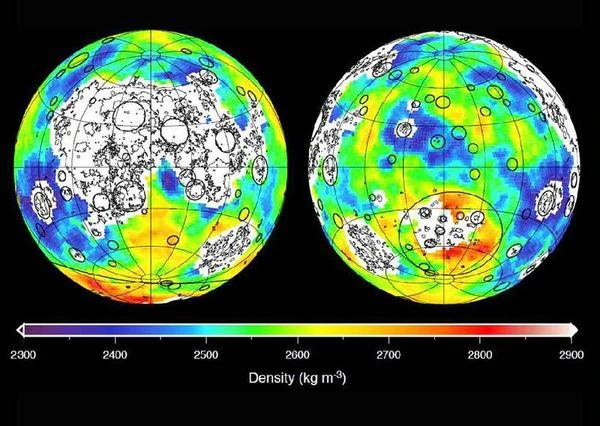
The Lunar Gravitational Anomalies are due to enormous mass concentrations called "Mascons".
The origin of lunar mascons has been a mystery in planetary science since their discovery in 1968 by a team at NASA's Jet Propulsion Laboratory in Pasadena, California.
The twin satellites of GRAIL (GRAIL A and GRAIL B) renamed Ebb and Flow identified the locations of the large dense regions or mascons. The mascons are irregularly distributed in the subsurface, particularly under the lunar seas. The Mascon basins on the Moon are the impact basins Mare Imbrium, Mare Serenitatis, Mare Crisium, and Mare Orientale. These basins have significant topographic depressions and positive gravitational anomalies. On Mars, the MASCON basins are Argyre Planitia, Isidis Planitia, and Utopia Planitia.
The local increases in lunar density, discovered around 1970, disrupt the trajectories of probes orbiting the Moon.
The two GRAIL probes shared the same orbit, separated from each other by a distance set by scientists according to their measurement needs. Once determined (between 75 and 225 km), this distance varies according to the gravitational field. By continuously measuring their separation, the two probes detect with great precision the irregularities of the lunar gravity field.
Thanks to these density measurements, the average thickness of the lunar crust has been estimated between 34 and 43 kilometers, 10 to 20 km thinner than expected. This characteristic shows that the composition of the Moon resembles that of the Earth.
The most accepted hypothesis for the formation of the Moon, that of a giant impact between the young Earth and a Mars-sized object, is reinforced. This episode dates back 4.2 billion years, the age given to the Moon by a team of researchers in 2009.
The probes, launched on September 10, 2011, and piloted by NASA teams, crashed on the Moon near the Goldschmidt crater on December 17, 2012. There were no images of the impact because the impact area was in a dark zone.
The model shows that the gravitational excess is a natural consequence of the shock that produced the excavation crater, the collapse, and the cooling following the impact. The increase in density and thus gravitation at the center of the mascon target is caused by lunar materials melted by the heat of an asteroid impact long ago.
Our planet has experienced similar impacts in its distant past, and understanding mascons can teach us more about ancient Earth. How plate tectonics began and what created the first mineral deposits.